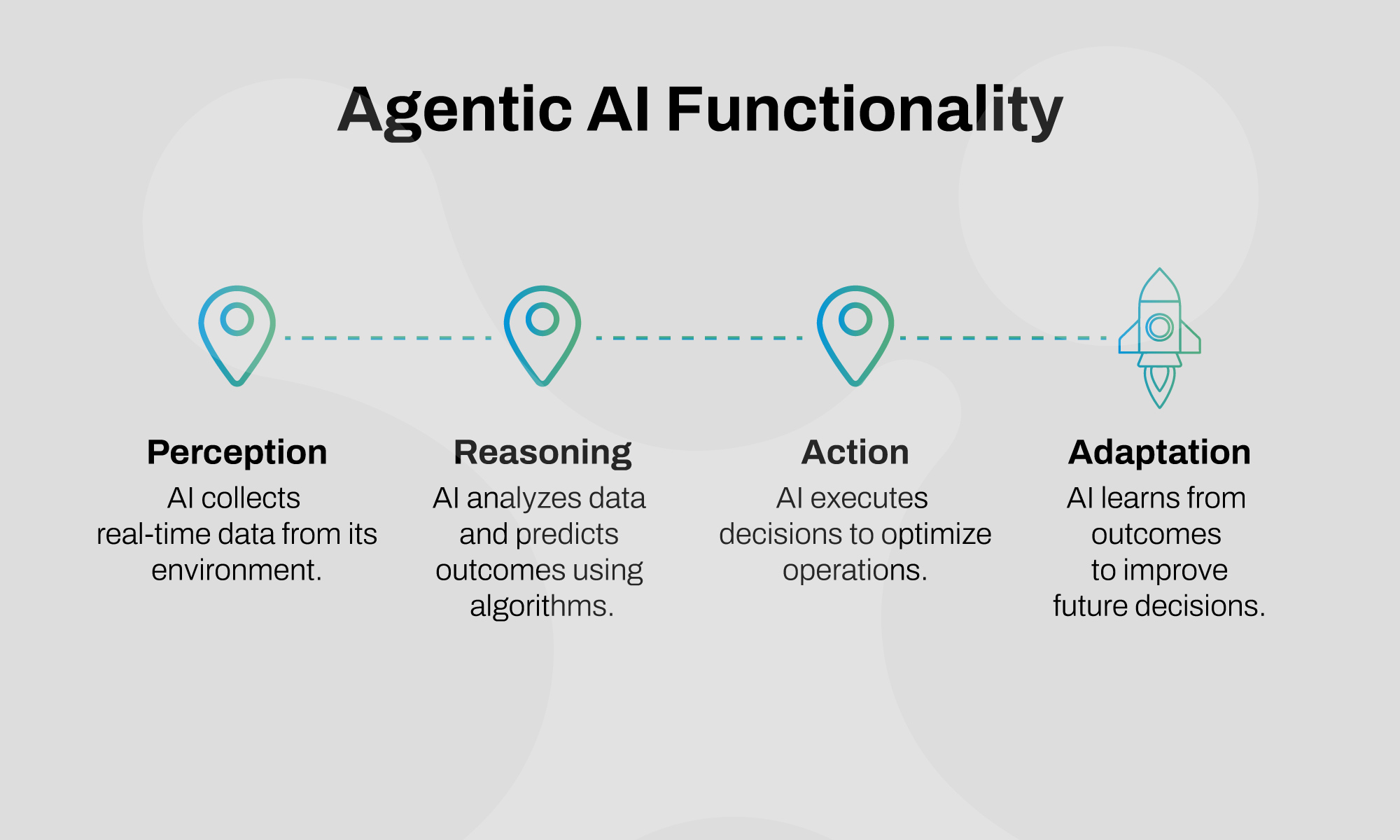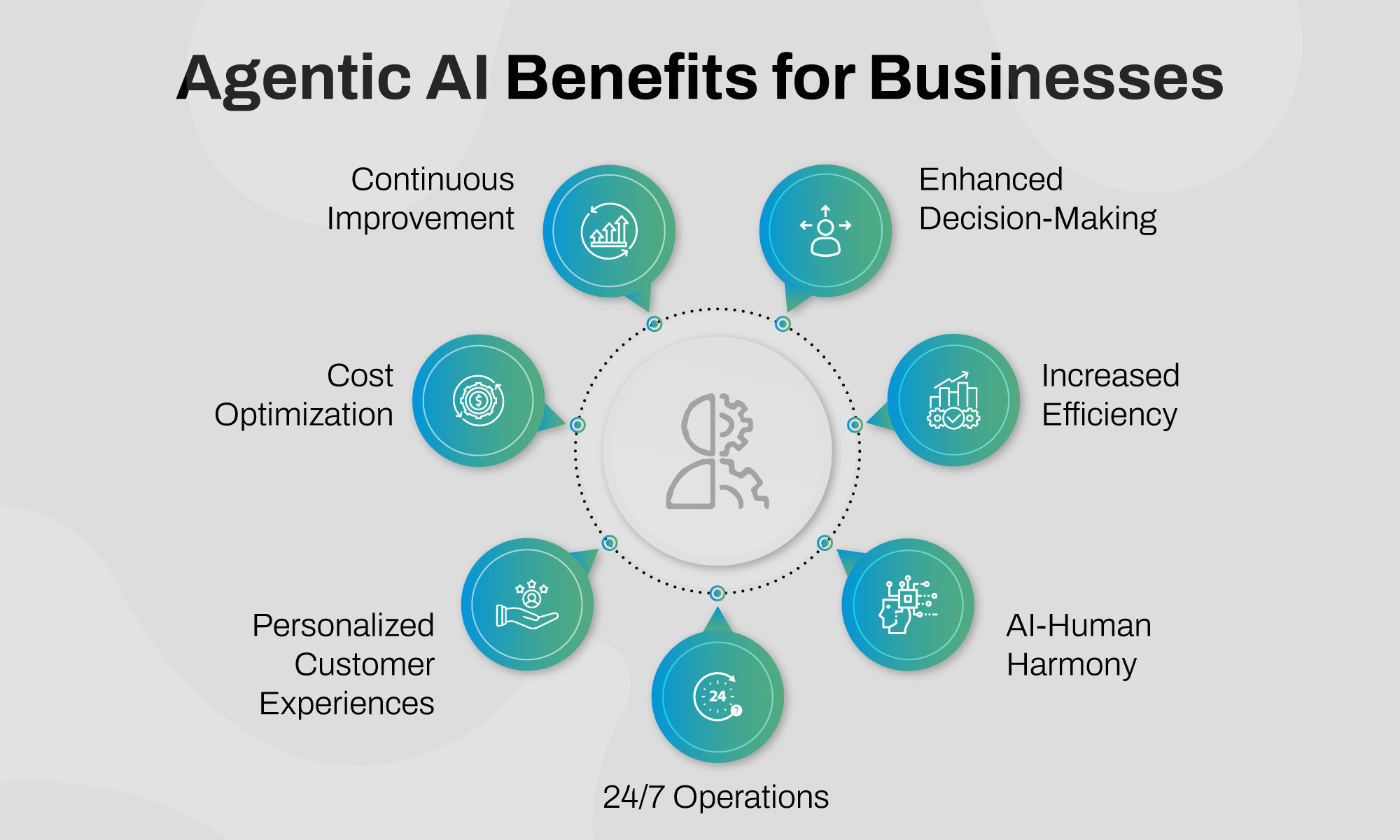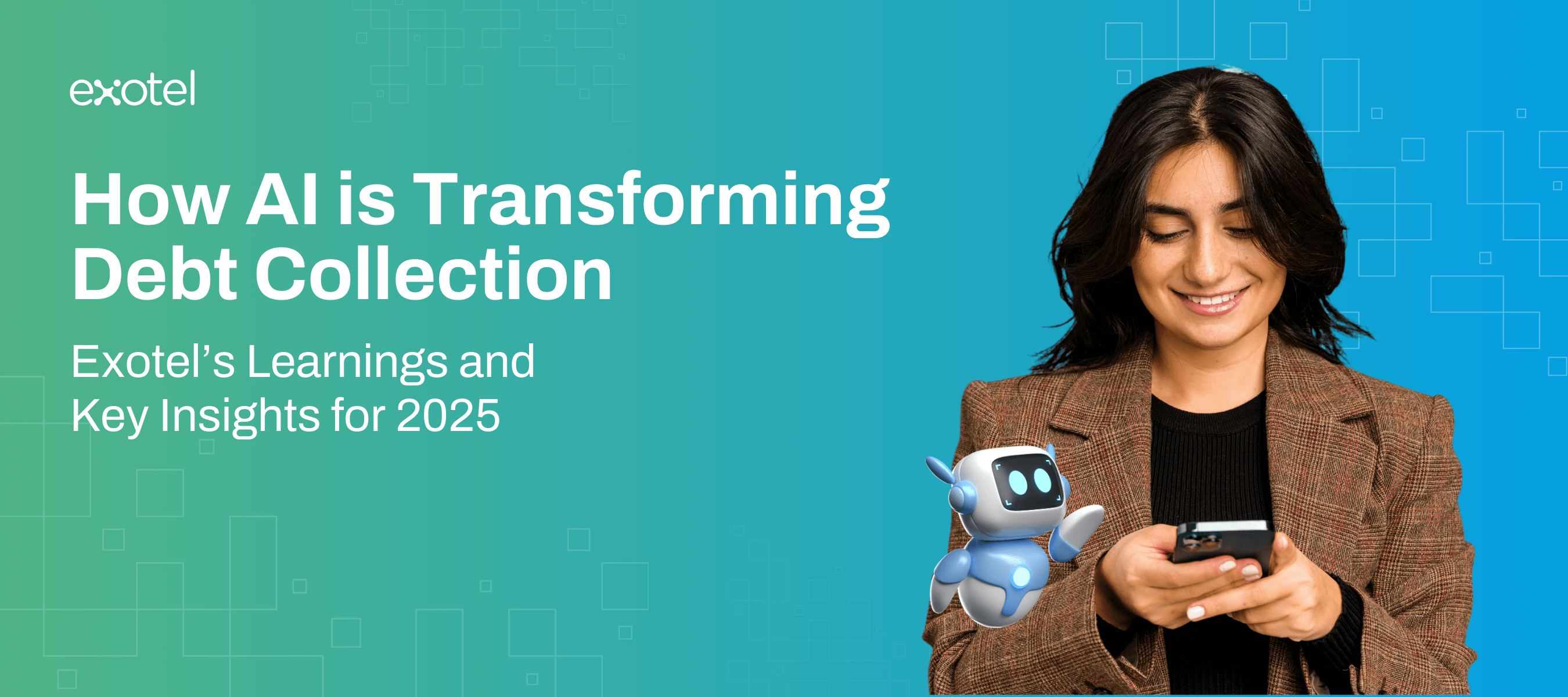AI is everywhere, shaping how we work, think, and connect—but not all AI is created equal. New in line is Agentic AI, whose name might sound like a humanoid on a secret mission, but its real mission is even more compelling.
Unlike, Generative AI, which labors with creativity, Agentic AI is about autonomy—making decisions, taking actions, and driving outcomes without constant human input. As we step into 2025, this emerging trend is redefining what it means for machines to “think.” Curious? Let’s unpack how Agentic AI is taking center stage in the evolving AI landscape.
What is Agentic AI?
Agentic AI is the next step in artificial intelligence evolution, designed to act autonomously, adapt intelligently, and achieve specific goals without constant human intervention. Unlike traditional AI models that rely on predefined instructions or generative AI that focuses on creating content, Agentic AI is task-driven and decision-making oriented. Think of it as an AI with a purpose: it doesn’t just generate outputs—it plans, executes, and learns from its actions to improve future outcomes.
At its core, Agentic AI combines machine learning, reinforcement learning, and real-time decision-making to analyze situations, weigh options, and take meaningful actions. This adaptability allows it to respond dynamically to changing environments, much like a human agent. It’s not just reactive but proactive, anticipating challenges and solving them within its defined objectives. Whether it’s optimizing supply chains, managing customer interactions, or navigating complex systems, Agentic AI operates with a clear mission in mind—delivering results efficiently.
This level of autonomy makes it uniquely suited for industries demanding high efficiency and low manual intervention. For businesses, it means less time micromanaging systems and more time focusing on strategy. As a goal-oriented AI, Agentic AI emphasizes outcomes over outputs, ensuring every action it takes is aligned with the desired result. It’s not just about intelligence; it’s about intelligence with intent.
What is the Difference Between Agentic AI and Generative AI?
Agentic AI and Generative AI—two buzzwords dominating the AI landscape—might seem interchangeable at first glance, but they couldn’t be more different. While Generative AI captivates with its ability to create, Agentic AI stands out for its decision-making and goal-oriented actions. One generates ideas; the other gets things done.
These distinctions matter because understanding their roles can help businesses leverage the right AI for their specific needs.
Here’s a breakdown to clarify their differences:
| Aspect | Agentic AI | Generative AI |
| Purpose | Goal-oriented and task-driven | Content creation and ideation |
| Functionality | Executes decisions and adapts autonomously | Generates text, images, or media based on prompts |
| Use Case | Automating workflows, optimizing systems | Writing articles, creating designs, coding |
| Autonomy | Acts independently to achieve specific outcomes | Requires human input to generate outputs |
| Learning Approach | Reinforcement learning for real-world adaptability | Pre-trained models for content generation |
| End Goal | Drive results and complete tasks efficiently | Inspire creativity and produce new content |
| Industries | Logistics, finance, customer support | Marketing, entertainment, creative fields |
Understanding these differences ensures you’re not just riding the AI hype but choosing the right tool for the right job.
How does Agentic AI Work?

Agentic AI operates as a dynamic problem-solver, working through a cycle of perceiving, reasoning, acting, and learning—each step building on the last.
First, it perceives its environment by collecting real-time data—whether that’s customer inputs, system feedback, or market trends.
This data feeds into its reasoning phase, where advanced algorithms like reinforcement learning analyze options and predict possible outcomes. Think of it as a strategist weighing risks and benefits before making a move.
Once the best course of action is determined, the AI acts—executing decisions like adjusting inventory levels, resolving customer queries, or deploying resources where they’re needed most.
But Agentic AI doesn’t just execute and forget; it actively learns from its outcomes. If a decision improves efficiency, the AI reinforces that approach. If it falls short, the system adapts, refining its strategies for future scenarios.
This continuous feedback loop allows Agentic AI to become smarter and more effective with every interaction, making it a powerful tool for achieving specific goals. It’s not just reacting to commands—it’s evolving to drive better results with each iteration.
Benefits of Agentic AI for Businesses

- Enhanced Decision-Making: Agentic AI analyzes customer interactions across voice, messaging, and chat in real time to determine the best course of action. For example, in a contact center, it can prioritize high-value customers and route their calls to the most skilled agents, ensuring faster resolution and improved satisfaction. This enables businesses to make data-driven decisions instantly.
- Increased Efficiency: By automating repetitive tasks like call routing, appointment scheduling, or FAQ chatbot, Agentic AI drastically reduces manual workloads. In conversational AI, it can handle thousands of simultaneous customer queries on messaging platforms, ensuring seamless communication without overburdening human agents. This leads to faster response times and higher productivity.
- AI-Human Synergy: Agentic AI complements human agents by handling initial touchpoints or routine issues, leaving agents to focus on complex or emotionally sensitive cases. For example, in a contact center, AI can gather customer information during the first few minutes of a call, allowing agents to jump straight into problem-solving. This results in more meaningful and efficient human-agent interactions.
- 24/7 Operations: Agentic AI ensures businesses remain accessible round the clock, especially in global customer service environments. On messaging platforms, AI can handle inquiries, update delivery statuses, or escalate urgent cases to on-call agents, providing uninterrupted support without needing additional human resources.
- Personalized Customer Experiences: Agentic AI tailors interactions based on real-time customer sentiment analysis. In voice communication, it can adjust its tone and language to match a caller’s mood, while in messaging, it can provide product recommendations based on past conversations. This level of personalization strengthens customer relationships and enhances satisfaction.
- Cost Optimization: By automating workflows such as call deflection to chatbots or handling low-priority queries via messaging, businesses save on operational costs. For example, an e-commerce company can use AI to handle billing inquiries on chat, reducing the need for expensive call center operations while maintaining high service quality.
- Continuous Improvement: Agentic AI learns from every customer interaction, refining its conversational AI flow, improving accuracy in sentiment detection, and enhancing its ability to resolve queries. For instance, a chatbot on a messaging platform can improve its responses over time by analyzing past customer feedback, ensuring smarter and more effective conversations with each interaction.
Impactful Agentic AI Use Cases Across Industries
→ BFSI: One of the biggest challenges in banking is balancing security with customer experience. Agentic AI addresses this by autonomously detecting and blocking fraudulent transactions in real time, reducing financial risk without slowing down legitimate processes. It also streamlines loan approvals by analyzing eligibility within seconds, removing bottlenecks in decision-making. For customer service and debt collection, it operates 24/7 via voice or chat, instantly resolving issues like account inquiries or policy renewals, significantly reducing payment due time, and improving customer satisfaction.
→ E-commerce: Managing large-scale operations while delivering personalized experiences is a constant struggle. Agentic AI serves as a virtual personal shopper, recommending products based on customer behavior and preferences, driving higher conversion rates. It dynamically optimizes pricing based on demand and competitor data, ensuring profitability. Post-purchase, it autonomously handles returns and tracks deliveries, offering a smooth experience while freeing up support teams to focus on more complex issues.
→ Hyperlocal Services: The hyperlocal industry often deals with last-mile inefficiencies and delayed deliveries. Agentic AI tackles this by analyzing traffic patterns, order density, and weather data to optimize delivery routes in real time, ensuring faster service. It autonomously updates customers about delays or ETAs via messaging, reducing frustration and increasing trust. Additionally, it identifies upselling opportunities, such as suggesting add-on services, boosting revenue without adding manual effort.
→ Logistics and Supply Chain: The logistics sector faces constant pressure to reduce costs and improve delivery times. Agentic AI autonomously optimizes delivery routes by analyzing real-time factors like traffic and warehouse conditions, significantly cutting transit times. It tracks shipments proactively, sending automated updates to customers, reducing inquiry volumes and enhancing customer service. Furthermore, it predicts maintenance needs for vehicles and machinery, preventing costly breakdowns and ensuring smooth operations.
→ Healthcare: Long wait times and administrative overload hinder effective patient care. Agentic AI transforms this by autonomously triaging symptoms via voice or chat, directing patients to the right care instantly. It handles appointment scheduling, lab result dissemination, and follow-up reminders, easing the workload on staff while ensuring patients get timely care. Its ability to adapt to individual patient needs enhances the quality and personalization of healthcare delivery.
→ Education: Personalized learning is often difficult to scale in traditional education. Agentic AI solves this by adapting content to each student’s pace and performance, fostering better engagement and outcomes. It provides round-the-clock academic support, answering queries about assignments, deadlines, or exam preparation via chatbots. Additionally, it automates administrative tasks like attendance tracking and fee reminders, allowing educators to focus more on teaching and less on logistics.
What is the Future of Agentic AI?
Agentic AI is set to revolutionize customer experience by orchestrating a cohesive ecosystem of AI systems, functioning as a ‘superagent’ that seamlessly manages and integrates various AI-driven processes. This advancement enables businesses to deliver hyper-personalized, efficient, and proactive customer interactions across multiple channels. By autonomously coordinating tasks such as real-time issue resolution, personalized recommendations, and predictive support, Agentic AI enhances operational efficiency and elevates customer experience.
This shift from isolated AI tools to an interconnected superagent ecosystem signifies a transformative leap in how businesses engage with customers, setting new standards for service excellence.
“By 2028, 33% of enterprise software applications will include agentic AI, up from less than 1% in 2024.”
 +91-808 8919 888
+91-808 8919 888 +91-808 8919 888
+91-808 8919 888 +966 135 181 912
+966 135 181 912




